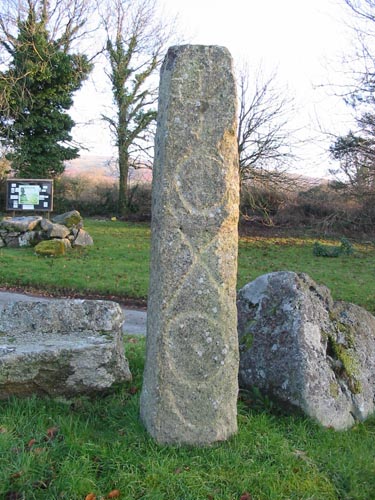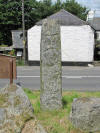 Location: On the village green, in
the centre of Sourton
Location: On the village green, in
the centre of Sourton
O/S Grid Ref: SX/53476/90320 Longitude/Latitude (Degrees+/-): -4.07592/50.69401
Map location: Click here to view map.
Purpose: Not known.
Size: 5 feet 5 inches (1.73 metres) high, 1 foot 4 inches (0.40 metres) wide at the base.
 Information:
This cross was found during
the 1980’s, in two pieces, propping up the roof of a nearby farm
building. On closer inspection it was found to be a Saxon cross of the 10th
Century, or earlier. Together with the assistance of local volunteers, it
was repaired and set up in its current position on the village green by
the Dartmoor National Park Authority in 1985. The two main faces have been
carved with Crosses, Circles and Saltires, as can be seen from the main
photo, which shows the side facing the main road.
Information:
This cross was found during
the 1980’s, in two pieces, propping up the roof of a nearby farm
building. On closer inspection it was found to be a Saxon cross of the 10th
Century, or earlier. Together with the assistance of local volunteers, it
was repaired and set up in its current position on the village green by
the Dartmoor National Park Authority in 1985. The two main faces have been
carved with Crosses, Circles and Saltires, as can be seen from the main
photo, which shows the side facing the main road.
A plaque, next to the cross, records the discovery and re-erection of the cross, which reads as follows:
|
This Christian
Stone |
Also on the
village green is the remains of the Sourton Village Cross. This
consists of a short length of cylindrical shaft, set into a
rectangular socket stone. The shaft was found during the
renovation of a nearby building, in about 1980 or 1981. At first
the significance of this discovery was not realised and
unfortunately it was broken into two lengths. In fact, the groove
where a drill bit was used to weaken the stone can still be seen
at the top of the  shaft.
Happily, once it was recognised as a cross shaft, the lower
portion was saved and has now been reunited with the socket stone.
shaft.
Happily, once it was recognised as a cross shaft, the lower
portion was saved and has now been reunited with the socket stone.
The remaining portion of the shaft measures 12 inches (0.30 metres) tall and 2 feet 11 inches (0.88 metres) in circumference. The lower end of the shaft terminates in a 9 inch square tenon, which is a very good match for the socket cut into the base stone. Nothing appears to be known of the whereabouts of the head and arms of this cross.
 Set back
behind the village green is the parish church of St Thomas of
Canterbury. Although the church is situated between the main road
and the, now closed, Okehampton to Tavistock railway line it is
nevertheless set in a picturesque and peaceful corner of the
village. Because of its dedication to St. Thomas à Becket it
might be thought that the church was built by William de Tracey,
as penance for his part in the murder of the Archbishop of
Canterbury. This is similar to the theory put forward for the
Bovey Tracey Church, as set out in our page on the Bovey
Tracey Churchyard Cross. As with the Bovey Tracey Church,
no evidence can be found to support this theory for the Sourton
Church.
Set back
behind the village green is the parish church of St Thomas of
Canterbury. Although the church is situated between the main road
and the, now closed, Okehampton to Tavistock railway line it is
nevertheless set in a picturesque and peaceful corner of the
village. Because of its dedication to St. Thomas à Becket it
might be thought that the church was built by William de Tracey,
as penance for his part in the murder of the Archbishop of
Canterbury. This is similar to the theory put forward for the
Bovey Tracey Church, as set out in our page on the Bovey
Tracey Churchyard Cross. As with the Bovey Tracey Church,
no evidence can be found to support this theory for the Sourton
Church.
As with many churchyards, some of the epitaphs on the gravestones make interesting reading. One from a gravestone near the church door, obviously in respect of a beloved husband waiting for the rest of his family to join him, reads as follows:
|
|
Weep not for me |